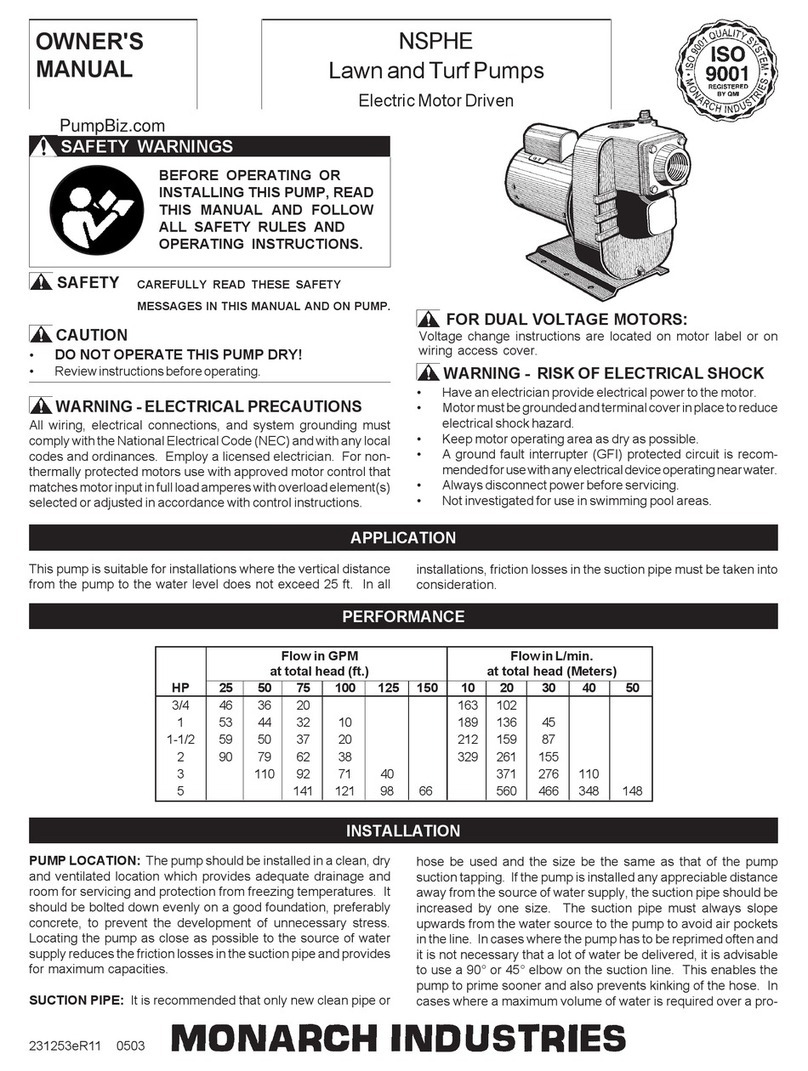
3
OPERATION - PRIMING THE PUMP
WARNING: DO NOT RUN THE PUMP BEFORE PRIMING IT, SINCE THE SEAL AND IMPELLER COULD BE
PERMANENTLY DAMAGED.
MAINTENANCE
WARNING - ELECTRICAL PRECAUTIONS
All wiring, electrical connections, and system grounding
must comply with the National Electrical Code (NEC) and
with any local codes and ordinances. Employ a licensed
electrician.
WARNING - RISK OF ELECTRICAL SHOCK
Before servicing motor operated equipment, shut off the power at
the main electrical panel and disconnect the power supply from the
motor and the accessories. Use safe working practices during
servicing of equipment.
a) Lubrication: The pump requires none. Refer to motor manufactur-
ers instructions for motor lubrication.
b) Cleanout plug: For applications where clogging is a problem, a
1/4" NPT plug has been provided for access to clean the nozzle/
venturi. This plug is located directly below the suction opening in the
front of the casing. IMPORTANT! Before removing the cleanout
plug, shut off the power to the pump at the main electrical panel.
Open a tap in the water system to release the pressure.
c) Replacing Mechanical Seal: (See Fig. 2)
Disassembly
1) Shut off the power to the pump at the main sevice panel.
2) Open a tap in the water system to release the pressure.
3) Remove the drain (12) and prime plugs to allow the pump to
drain.
4) Remove the 4 bolts (1) and remove casing (2).
5) Pry the diffuser (4) out of the casing using 2 slotted screwdriv-
ers for leverage.
6) Remove cap (5) and insert a screwdriver to prevent the shaft
from turning while unscrewing the impeller (6)(GE m o -
tors). For A.O. Smith motors, remove rear cover and hold the
shaft using a flat wrench inserted from the side, through the
opening in the end of the housing. If the impeller cannot be
turned by hand, insert a flat object into the impeller vane.
7) Slip the rotating seal (7) off the shaft and remove the seal plate
(8).
8) Remove the ceramic seal seat (9) from the seal plate. Fig.2
Reassembly
1) Clean all the parts thoroughly before assembling.
2) Push ceramic seal (9) it into the seal plate using thumbs only.
Make sure the smooth surface of the ceramic seat faces
outwards.
3) Put the seal plate back on the motor.
4) Slip on rotating seal (7) to the shaft with the 'carbon' ring
towards the ceramic seat.
5) Replace the impeller (6) and the diffuser (4).
6) Replace the casing (2) making sure that the venturi is properly
seated, and that the gasket is not damaged and is in place.
7) Reinstall the drain plugs.
8) Reconnect the power.
9) Prime pump, start, check for leaks.
a) Priming: Do not run the pump before priming it, since the seal and impeller
could be permanently damaged. Remove the plug from the street tee and
pour clean water into the unit until casing and suction line are completely
filled. Replace the priming plug and start the motor. If the unit is properly
primed, it should pump almost immediately. If not, repeat the priming
procedure until all the air has been eliminated from the suction line. If an
in-line check valve is used in place of a foot valve, the initial priming time
may take 5 to 15 minutes depending on the suction lift, (higher suction lift
requires longer priming times). At 10 feet or greater suction lifts, water
should be added to the casing approximately every 3 min-
utes until primed. If the pump does not prime within 25
minutes, stop the pump and check for suction leaks.
b) Draining: Should the unit be subject to freezing, it will be
necessary to drain the pump and tank. To do this, shut off the
power to the pump at the main electrical service panel. Open
a valve in the system to release the pressure. Remove drain
and priming plugs from the casing. Allow ample time for
system to drain before reinstalling the plugs!























